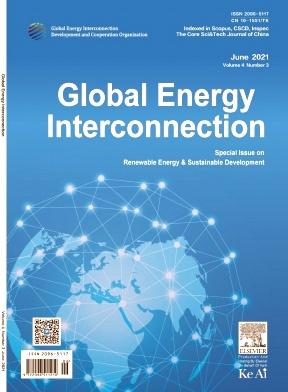Study the effect of using a dual rotor system on the performance of horizontal axis wind turbines using CFD
IF 2.6
Q4 ENERGY & FUELS
引用次数: 0
Abstract
This research aims to improve the power output of a horizontal axis wind turbine (HAWT) by using an auxiliary rotor in front of the main rotor, this configuration is called a dual-rotor wind turbine (DRWT). The three-bladed main rotor has a diameter of 0.9 m and both rotors with NREL S826 airfoil. ANSYS Fluent CFD simulation was used to optimize the DRWT performance where the numerical model was solved using the Realizable k-ɛ turbulence model. Four parameters are used, diameter ratio between the auxiliary front rotor and the main rear rotor (DR = 0.25, DR = 0.5, and DR = 0.75), axial free stream velocity according to the normal wind speed range in Egypt (Vo = 5 m/s, Vo = 7.5 m/s, and Vo = 10 m/s), tip speed ratio which ranges from 2 to 8, and the number of blades of the front rotor (B = 2, B = 3 and B = 4). The results show that increasing the number of blades positively impacts performance but at lower tip speed ratios. Smaller diameter ratios yield better performance, while increasing wind speed results in higher power. The best performance was achieved at freestream velocity Vo = 10 m/s, diameter ratio DR = 0.25, front rotor number of blades B = 4, and tip speed ratio λ = 5 in which the overall maximum power coefficient Cp max = 0.552 with an increase with 36.75 % compared to the single rotor case.
利用CFD研究了双转子系统对水平轴风力机性能的影响
本研究的目的是在水平轴风力机(HAWT)的主转子前面增加一个辅助转子来提高其功率输出,这种结构称为双转子风力机(DRWT)。三叶主旋翼直径0.9米,两个旋翼都采用NREL S826翼型。采用ANSYS Fluent CFD仿真对DRWT性能进行优化,采用Realizable k- ε湍流模型求解数值模型。采用辅助前转子与主后转子直径比(DR = 0.25, DR = 0.5, DR = 0.75),根据埃及正常风速范围的轴向自由流速度(Vo = 5m /s, Vo = 7.5 m/s, Vo = 10m /s),叶顶速比2 ~ 8,前转子叶片数(B = 2, B = 3, B = 4)四个参数。结果表明,增加叶片数量对性能有积极影响,但叶尖速比较低。较小的直径比产生更好的性能,而增加风速产生更高的功率。在自由流速度Vo = 10 m/s、直径比DR = 0.25、前旋翼叶数B = 4、叶尖速比λ = 5时,总最大功率系数Cp max = 0.552,比单转子情况提高36.75%。
本文章由计算机程序翻译,如有差异,请以英文原文为准。
求助全文
约1分钟内获得全文
求助全文
来源期刊

Global Energy Interconnection
Engineering-Automotive Engineering
CiteScore
5.70
自引率
0.00%
发文量
985
审稿时长
15 weeks
 求助内容:
求助内容: 应助结果提醒方式:
应助结果提醒方式:


